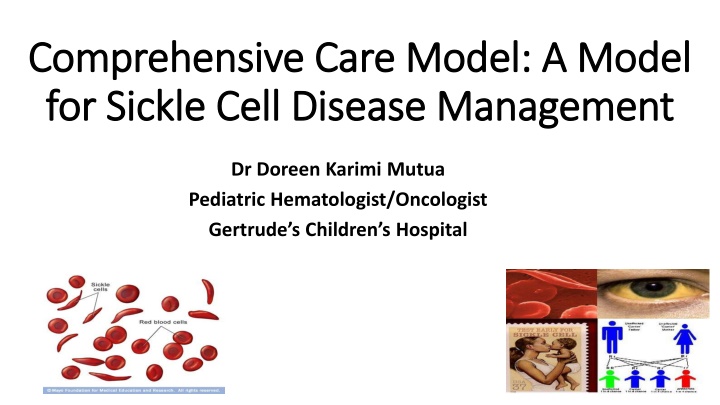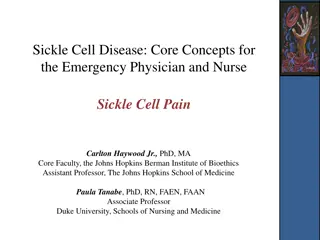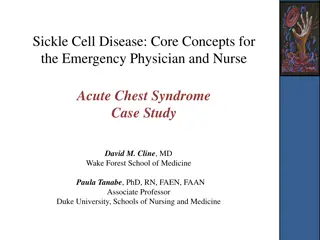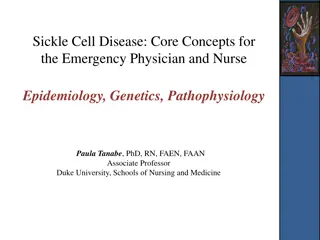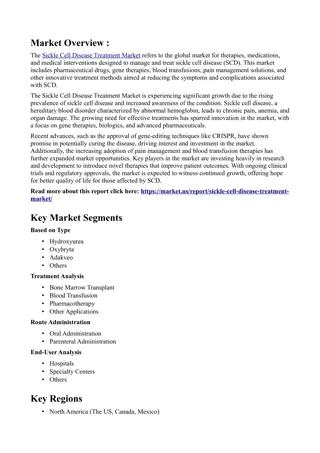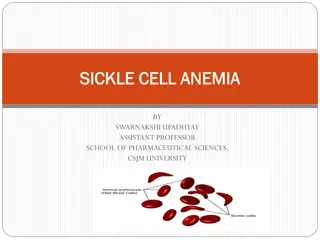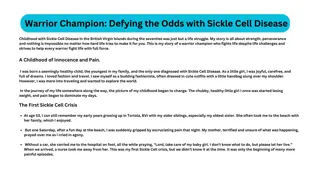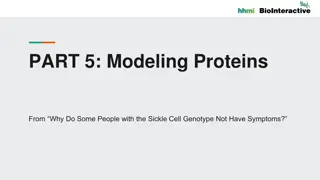Comprehensive Care Model for Sickle Cell Disease Management
Comprehensive care is crucial for managing sickle cell disease, the most common haemoglobinopathy worldwide. Despite advancements in high-income countries, challenges persist in low and medium-income nations, leading to preventable deaths, especially in Africa. A comprehensive care approach has significantly improved survival rates, with remarkable results in developed nations. The need for systemic screening, research, and interventions is clear to address the barriers to effective care.
Download Presentation

Please find below an Image/Link to download the presentation.
The content on the website is provided AS IS for your information and personal use only. It may not be sold, licensed, or shared on other websites without obtaining consent from the author.If you encounter any issues during the download, it is possible that the publisher has removed the file from their server.
You are allowed to download the files provided on this website for personal or commercial use, subject to the condition that they are used lawfully. All files are the property of their respective owners.
The content on the website is provided AS IS for your information and personal use only. It may not be sold, licensed, or shared on other websites without obtaining consent from the author.
E N D
Presentation Transcript
Comprehensive Care Model: A Model Comprehensive Care Model: A Model for Sickle Cell Disease Management for Sickle Cell Disease Management Dr Doreen Karimi Mutua Pediatric Hematologist/Oncologist Gertrude s Children s Hospital
Outline History Status of Sickle Cell Disease Care Rationale of Comprehensive Care in Sickle Cell Disease Landmark studies Components of Comprehensive Sickle cell Care Action Plan for Kenya Summary
Its 100 years already!! It s 100 years already!!
From the Forefathers of Medicine: Hippocrates From the Forefathers of Medicine: Hippocrates (460 (460- -377 B.C.E.) 377 B.C.E.) Another sickness of the spleen. It comes on mainly in the springtime and is caused by the blood. The spleen becomes engorged with blood, which evacuates into the stomach. Shooting pains in the spleen, the breast, the clavicle, the shoulder, and beneath the shoulder blade. The body s coloration resembles lead. Sores form on the leg and become large ulcerations. The discharges with the feces are bloody and bluish green. The belly hardens and the spleen is like a stone. This one is more murderous than the one before, and few survive it.
Sickle Cell disease (SCD) Sickle Cell disease (SCD) SCD is the commonest haemoglobinopathy in the world There are about 300,000 children born with SCD every year, 70-75% are in Africa Estimated life expectancy for SCD in high income countries is 45-50years but in low and Medium income countries more than 50 % of these children die before their 5th birthday 70% of the deaths in SCD are preventable Challenges: Lack of basic facilities to manage patients, absence of systemic screening for SCD, poor research, documentation, and intervention protocols Hsu L, Nnodu OE et al. White Paper: Pathways to Progress in Newborn Screening for Sickle Cell Disease in Sub-Saharan Africa. J Trop Dis Public Heath. 2018;6(2):260 Wastnedge E, Waters D, Patel S.The global burden of sickle cell disease in children under five years of age: a systematic review and meta-analysis. J Glob Health. 2018 Dec;8(2):021103
Rationale of Comprehensive SCD care Rationale of Comprehensive SCD care Comprehensive care plan has led to a marked increase in survival for children with SCD It is now rare for children with SCD to die in developed countries, with a reported survival into adulthood of 94% in the United States and up to 99% in England The 59th World Health Assembly (WHA) in 2006, identified SCD as a significant public health problem in Africa that may contribute to up to 16% of under-5 mortality in some countries WHA resolution 59.20 urged African nations with high burdens of SCD to design and implement national SCD programs with a focus on Widespread awareness-raising Early identification by Newborn screening(NBS) Early access to adequate preventative care, and training of medical professionals on SCD June 19th as World Sickle Cell Day: the United Nations issued a call for action among African nations to address the unmet burden of SCD
Land mark studies: Natural History of SCD Land mark studies: Natural History of SCD Cooperative Study on Sickle Cell Disease(CSSD) Natural history of SCD Newborn cohort- majority of deaths occurring in the first six months of life Major events in children: infections, anemia Increased Hb F associated with mild disease 50% of adults died before 5th decade: acute pain, acute chest syndrome, stroke Hydroxyurea use reduces pain episode by 45%, acute chest syndrome by 44% and blood transfusion by 30%
Land mark studies: Penicillin prophylaxis Land mark studies: Penicillin prophylaxis Prophylatic Penicillin Study(PROPS) Despite universal coverage of the pneumococcal vaccine, Streptococcal infections significantly caused morbidity and mortality until Penicillin prophylaxis was introduced
Land mark studies: Hydroxyurea use in children Land mark studies: Hydroxyurea use in children Ped- HUG trial lower rates of initial and recurrent episodes of pain, dactylitis, acute chest syndrome, and hospitalization, Reduction in hemolysis, Increased Hb F, Reversible and predictable adverse effects of Hydroxyurea Baby- HUG trial Beneficial effects on splenic function preservation ?effect on proteinuria, hypoxemia No safety concerns
Land mark studies: Stroke in Sickle Cell Disease Land mark studies: Stroke in Sickle Cell Disease Chronic transfusion in primary and secondary stroke prevention STOP Trials Chronic transfusion and chelation therapy superior to Hydroxyurea/phlebotomy in stroke prevention SWiTCH trial TWITCH Hydroxyurea is effective in stroke prevention in patients with abnormal transcranial ultrasound velocity
Land mark studies: Hydroxyurea safe and effective Land mark studies: Hydroxyurea safe and effective for sickle cell anemia in African children for sickle cell anemia in African children REACH trial (Kenya amongst 4 countries involved) Among sub-Saharan African children with sickle cell anemia (SCA) treated with hydroxyurea, 5.1% experienced dose-limiting toxic events, well below the protocol-specified allowable rate of 30%. Compared to pretreatment rates, children treated with hydroxyurea had significantly reduced rates of vaso-occlusive pain, infection, malaria, transfusion, and death after one year.
Components of Comprehensive Care Model Components of Comprehensive Care Model Newborn screening Health Education to Families Nutritional support Prophylactic Penicillin Prophylaxis Psychosocial support Immunization practices Comprehensive Care SCD Malaria infection prevention Screening for Chronic organ damage Management of acute complications Hydroxyurea use
Where do we begin? Where do we begin? Kenya is listed amongst the countries with high burden for SCD It has been shown that Newborn screening and link to comprehensive care centers is cost effective Early introduction of penicillin prophylaxis Health education to families during the patient visits Immunization program already active Ensure availability of Hydroxyurea Ensure availability of pain medication and safe blood products Establish multidisciplinary care Establish guidelines on chronic organ damage screening: Urinalysis, Transcranial Doppler, Ophthalmology reviews, Iron overload screening, Echocardiography
Summary Children with SCD have the potential to live and let live with decreased morbidity and mortality This requires an adoption and commitment to comprehensive care approach to their management Lets hear a word from the Kenya Sickle Cell Foundation Chair! Thank You!
